How To Set Up Tent In Rain
Anybody that regularly goes camping volition eventually get caught in the rain. A picayune flake of rain doesn't have to ruin your trip, but setting up a tent in the pelting can exist a challenge. The inside of your tent will be soaked with pelting if you don't know what you're doing. You tin can avoid that trouble by following this guide where I explicate How to ready a tent in the rain.
Camping in the pelting isn't anybody's idea of the perfect trip, but unfortunately there's no 100% accurate way to predict the weather. The weather forecast can await perfect all week and all of a sudden change as y'all're jumping in the motorcar to head out.
Don't cancel your trip simply still! You lot can still take fun camping in the pelting, but you'll need to know a few uncomplicated tips to get started. And so how practice you gear up a tent in the rain without soaking the inside of your tent?
How To Ready A Tent In The Pelting
I've had to pitch a tent in the rain countless times, and you always run into the same problems. The within of your tent gets wet during setup, y'all track water into the tent, or bring wet gear inside. I'll teach you how to deal with each of these bug and become over everything else you need to know.
You likewise demand to learn how to choose a campsite to avert flooding problems. Choose a rubber military camp without falling objects or the risk of getting struck by lighting. Deal with waterproofing, drying wet gear, and testing/fixing leaks. Plus give you lot a few options to amend ventilation and eliminate condensation.
Once your done with this post, I highly recommend checking out my camping the rain ultimate guide. It goes over every other aspect that y'all need to know about camping ground in the rain.
Here's A Few Quick Tips To Help Pitch A Tent In The Rain!
ane. Wait For The Weather To Clear Upwards

This should seem adequately obvious, simply do you actually need to fix upwards your tent in the rain? Check the weather forecast and come across how long it will take for the rain to terminate. If in that location's whatsoever chance that the rain will terminate in the adjacent thirty-hr consider waiting out the tempest.
Toss on your pelting gear and pick a safety tree to take encompass for a fleck. This will give you a chance to see where water pools upwards and you won't have to bargain with rain soaking through the mesh roof of a double wall tent.
This isn't always possible, just information technology'southward better to start off on a positive note. I'll become over ways to minimize the risk, just rain volition find a way inside your tent. Information technology tin atomic number 82 to condensation issues if yous don't learn how to bargain with information technology.
2. Make A Sheltered Area With A Lightweight Tarp
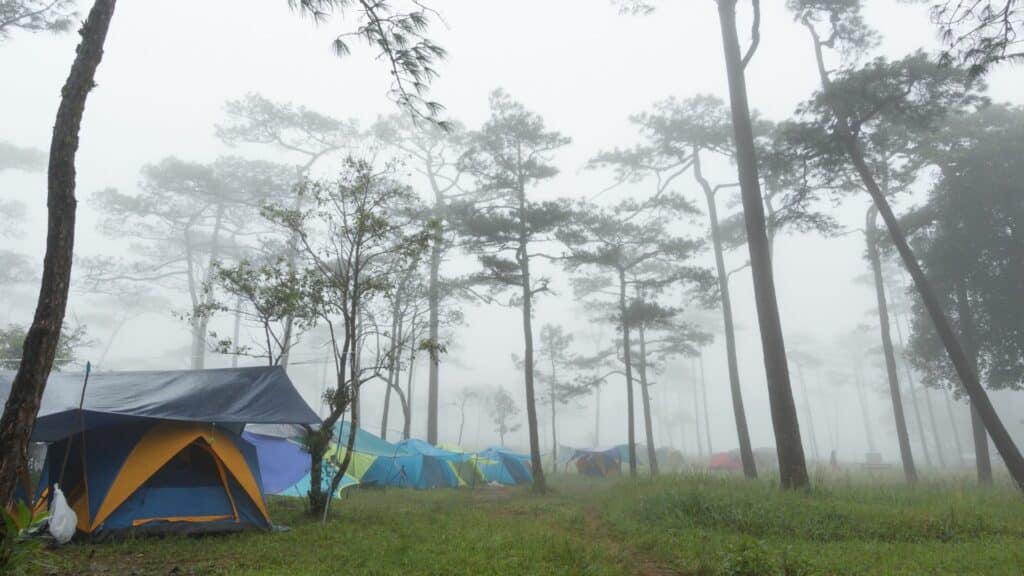
Use a tarp to create a sheltered area, while you prepare a tent in the rain. Your sheltered area will serve two purposes: it gives you a identify to stay dry while y'all're hanging out and you also accept embrace while pitching your tent in the rain.
I recommend setting up the tent so the back edge of the tarp goes barely over the mesh department of a double wall tent. You tin can get back further with a unmarried wall tent, but make certain your doors/windows are zipped upward to keep out rain.
Y'all can use any tarp to set up a sheltered area, merely I recommend purchasing a "Real" camping ground tarp. They're a little bit lighter than regular tarps like yous'd find at Home Depot, Lowes, etc. and much easier to fold, pack, and handle. I apply Redcamp waterproof camping tarps, since they're cheap and durable, merely there are lighter options available for similar iv times the price.
If pack weight isn't a concern for hiking, I recommend buying the largest tarp you tin can find. A massive 9ft by 13ft Redcamp weighs less than 3lbs so it really won't add that much weight to your pack anyway. I've been known to carry a second tarp and extra guy lines when there's a high chance of rain. It gives you actress space to sit and dry all your gear.
How To Build A Sheltered Area With A Tarp
Creating a sheltered area with a tarp is easy. Simply run a single guy line between ii trees at your preferred height. Necktie a guy line to each corner of the tarp, pull out each corner, and stake down your lines. You lot can gear up a tarp without copse, but y'all'll need additional support poles to human activity as makeshift trees.
Bank check out my post explaining how to hang a tarp over a tent without trees for more info.
Just make sure you angle the tarp with the back edge past the middle of your tent. That should forcefulness the rain to drain away from your seating area. You don't want to sit in a muddy mess and accept h2o running into your door.
3. Tree Cover To Protect Your Tent From The Rain (Avoid Falling Objects)
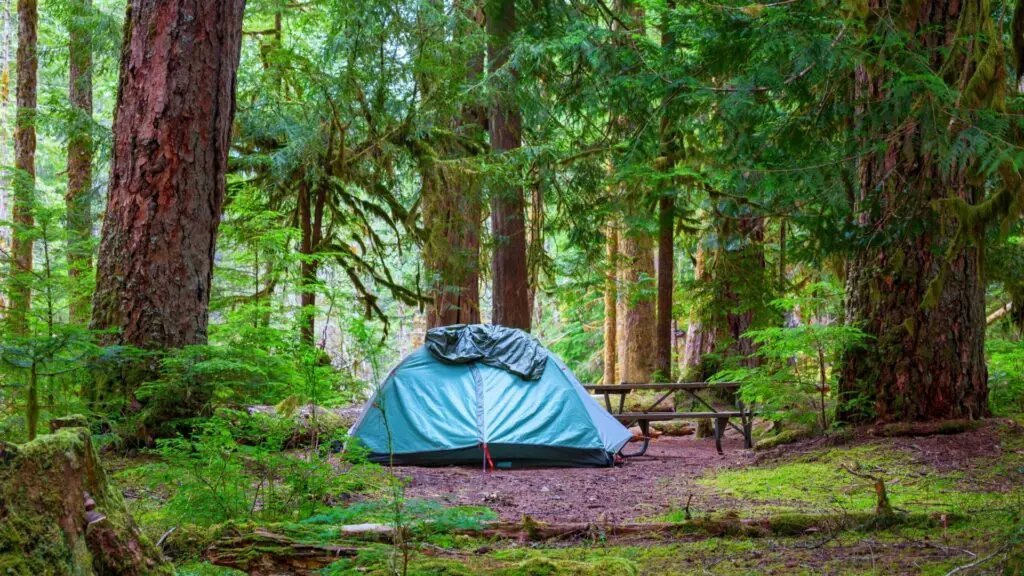
Use tree cover to shelter your tent from rain and reduce the risk of condensation forming within the tent. Yous simply need to be careful when setting up the tent. It's extremely common for dead or loose hanging tree branches to autumn during a tempest.
Look up into the tree canopy to check for dead branches and hanging limbs (aka widowmakers). It's rare for a salubrious branch to break loose, but that's too possible in heavy rain. I had a one inch co-operative tear through the roof of my garage and brand its way into the finished area below. If a smallish branch can rip through a plywood roof, it tin can easily tear through your body.
Also keep an eye out for pinecones, acorns, and any other type of fruit. An acorn bonking y'all on the caput, probably wouldn't kill y'all, but it definitely hurts. I had one fall on my head while cleaning out my gutters and I wobbled almost falling off my ladder.
Cheque out my post explaining whether or not you should pitch a tent under a tree.
iv. Accept Special Precautions With Thunder and Lightning
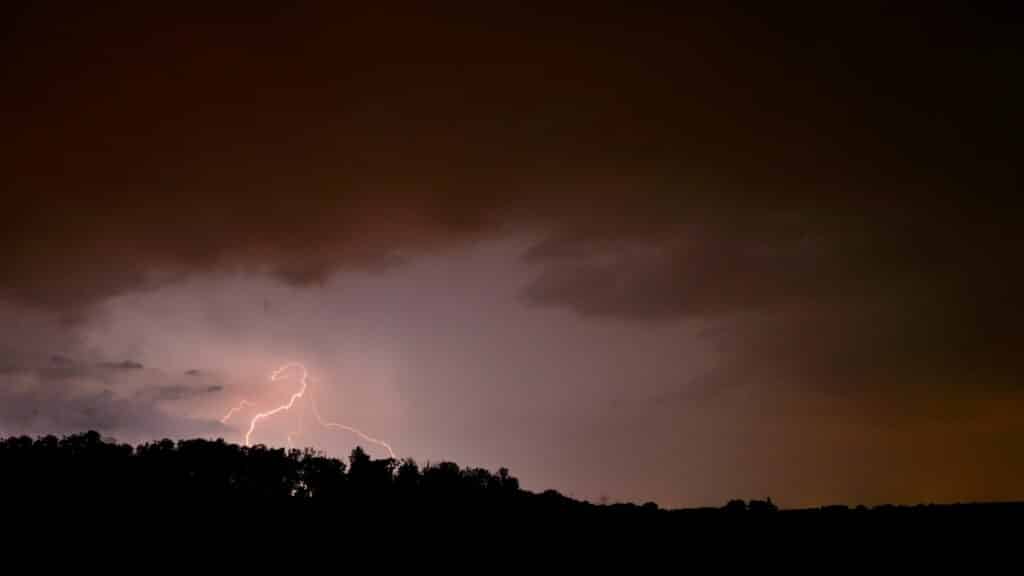
We've all been trained that it's dangerous to stand under a tree during a thunderstorm, but that's misleading. It's only dangerous when you gear up a tent nether a unmarried tree or on the border of a forest. Going deep into a woods during a lightning storm really reduces your gamble of getting struck by lightning.
Lightning usually hits the tallest object information technology tin notice, merely there'south no designated loftier spot in a forest. It's kind of like you've moved the ground up 100 feet. The forest awning is one giant mass of similar height trees so as you get deep inside a densely grown forest the risk of getting struck past lightning isn't higher than in other places.
Check out my mail service explaining why tents are condom in a thunderstorm.
5. Pick An Elevated Campsite With Proper Drainage
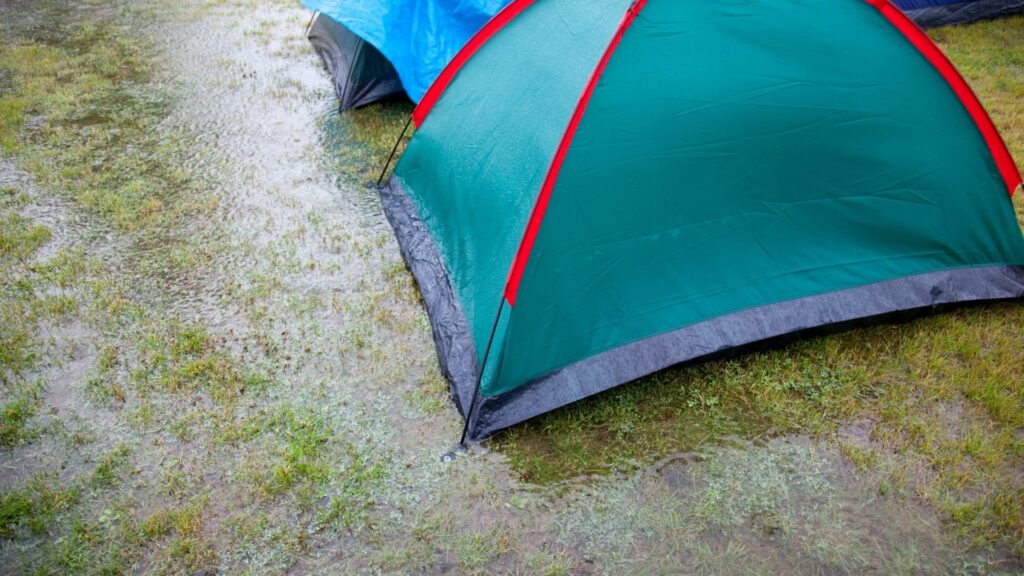
You demand to take extra precautions when picking the perfect spot to prepare up a tent in the pelting. There are 3 key things you lot need to consider. Check for depression spots, consider the flow of water, and try to find a spot with expert drainage.
- Don't Pitch A Tent In Low Spots: Look at the lay of the land and try to avoid depression spots when there's any adventure of rain. Water always collects at the lowest point so that's a terrible identify to fix up campsite. Near tents take waterproof bathtub floors (unless it's floorless), just yous wouldn't want to hang out in a mud pit all weekend.
- Endeavour To Predict The Flow Of Water: Check the soil and attempt to effigy out the menstruum of water. Water always flows down to the lowest point so effort to visualize where the rain h2o will menstruum. Yous can usually spot signs of flowing water: piles of loose debris, paths of soil erosion, or moss, fungus and other plants that prefer wet environments.
- Consider The Soil Drainage: Finding a spot with proficient soil drainage tin be a challenge. Rain obviously can't drain through rocks, but it also has a hard time penetrating clay filled soil. You can check the soil consistency by pushing a tent stake into the ground. If the stake pushes and pulls out hands/clean it's sandy well draining soil. When it feels similar you're pushing through muck that's clay filled soil that will crusade drainage issues.
That might seem complicated, but y'all'll speedily larn how to spot well draining campsites. I offset off by looking for small hills, just if that's non possible I look for flat soil where there isn't low spots or higher ground leading to the site. Examination the soil to see what it's made out of and you should exist good to become.
half-dozen. Work On Keeping The Inside Of Your Tent Dry and Do Before You Go Out
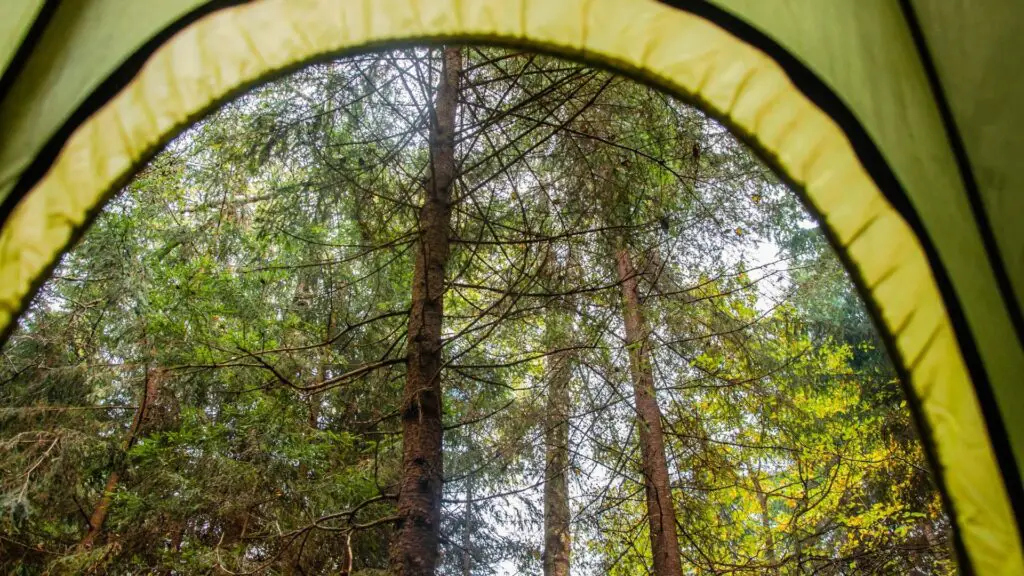
Unmarried wall tents are entirely waterproof once you zip up the windows and doors so this section only applies to double wall tents. If your tent has a mesh roof/walls, that means information technology'south a double wall tent. Setting upwards a double wall tent in the pelting can lead to h2o problems, merely I'll go over a few tips to reduce the risk.
With most double wall tents you demand to set up the inner mesh tent offset and then set up up the waterproof rainfly. This can lead to water soaking the mesh ceiling and draining into the tent soaking the floor and sidewalls. Nobody wants to sleep on a soaking wet floor and the wet ceiling tin can cause condensation problems (plus the baste factor).
- Set Up A Tarp Over The Tent: I explained this footstep above (click here to jump to that section), but it's extremely of import so I'll repeat myself. You should seriously consider using a tarp (my favorite) to prepare a sheltered area to set your tent under.
- Separate Each Part Of Your Tent: Unremarkably I'thou lazy and roll my tent into a big ball that I jam into my stuff sack. That's a terrible idea if you lot're trying to prepare a tent in the pelting. Keep your poles, main tent, and rain fly dissever so you can pull out 1 piece at a time. Accept each role out separately to reduce the time your tent will be exposed to rain.
- Continue The Door Zipped: Trying to close a door on a crumpled up tent is a challenge, and then make a habit of always closing the door on your tent when you pack it up. You don't want water going in through the open door while pitching the tent.
- Keep The Height Of Your Pelting Fly Up: Brand certain the top of your rainfly is the only office exposed to the pelting. Y'all don't want the inside of your rainfly to get wet. It volition take forever to dry, baste down into your tent, and cause condensation problems.
- Knock Water Off The Mesh On Your Tent: The mesh on your tents roof should exist somewhat waterproof, but it will eventually leak so you demand to knock/towel off most of the water. Shake your roof, wipe information technology with a towel, and then put on the rainfly.
- Wipe Down Your Tent With A Towel: I always carry 2-3 microfiber camp towels to use around camp. You will definitely demand a towel to wipe down your tent'south flooring, ceiling, and walls. A little scrap of rain volition always get inside when setting up a tent in the pelting. Even if yous avoid it at the beginning you lot will somewhen walk through the tent with wet shoes, clothes, or gear. This will most e'er atomic number 82 to condensation issues since it's then humid during a rainstorm.
- Practice Setting Upward The Tent Before Your Trip: I've been camping for decades and the first time I setup a tent information technology commonly takes 20-30 minutes to effigy everything out. After I figure out where everything goes it takes less than 10 minutes to pitch the aforementioned tent. Now I tin can pitch my tent and go my rainfly up in v minutes when I'chiliad rushing in the rain.
vii. Test Your Tent For Leaks Before The Trip

This is rarely an effect with brand new tents, just brand sure yous test your tent for leaks before the trip. Spray your rainfly, the seams, and lesser of your tent with a hose. Bank check within the tent for leaks and
I unremarkably apply a DWR spray to the outside of my tent at the beginning of each camping flavor and check all the seams for leaks. I like Nikwax DWR Spray, because it cleans the tent and adds UV protection, merely Kiwi Camp Dry is a cheaper option if you just want waterproofing.
Dealing with leaking tent seams is much harder, simply information technology's notwithstanding not that bad. Don't waste your money on dedicated tent seam sealers like Gear Assist Seam Grip. It's just a tiny overpriced tube of silicone caulk and it would take multiple tubes to do an entire tent.
I become through all the dissimilar options you lot can choose from in my tent seam sealer alternative post, just Shoe Goo is probably your all-time bet. A tube of Shoe Goo is exactly the aforementioned affair as "existent" tent seam sealers, twice the size, and much cheaper. Silicone based products are a gunky/globby mess to apply so I like to thin it with mineral spirits.
Check out my post that explains how to sparse tent seam sealer and how to make homemade seam sealer for more info.
My how to make homemade seam sealer postal service explains making big batches of tent seam sealer out of 100% silicone window caulk. That's by far the cheapest option if you desire to redo the seams on your entire tent. Silicone window caulk costs like $5 at Home Depot and you can do multiple tents plus all your gear with one tube.
8. Learn How To Properly Use A Tent Footprint or Footing Cloth
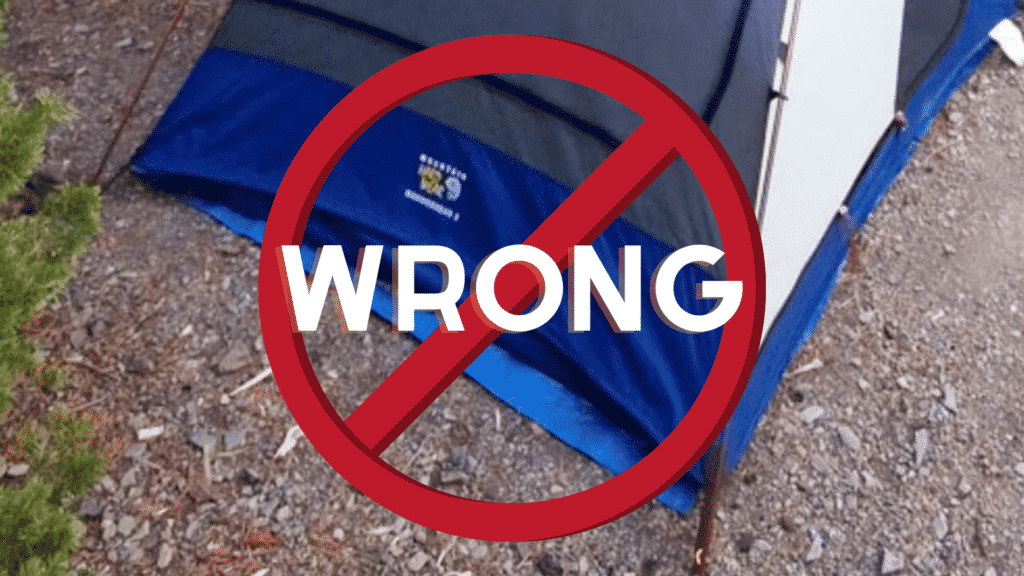
About people are under the false impression that tent footprints proceed water out of your tent. It may assistance if at that place's a pigsty in your tent flooring, merely that's non the primary purpose. Your tent footprint protects the flooring from punctures and keeps mud off the lesser of your tent.
Information technology shouldn't be difficult to figure out why you lot would want to keep mud off your tent. Cleaning off the bottom of a tent is a serious hurting. You take to set up the tent, flip information technology over on it's side, and scrub the heck out of it. And so yous need to get out the tent upwards for 24 hours to dry in the sun.
Washing off the bottom of a tent footprint is much easier. I unremarkably use a depression power pressure washer to clean off my tent footprint. I'm not worried about damaging a $20 footprint, but I would never consider use a pressure level washer on my tent ($200+). Just lay out the footprint, spray it off, and requite it a few hours to dry out.
You can utilize a tarp equally a tent footprint, simply real footprints are reasonably priced. Distressing for sounding like a Redcamp salesman, simply they also sell high quality reasonably priced ultralight tent footprints. But make sure you choose a model that's a few inches smaller than outside edges of your tent (doesn't have to exist perfect).
Make Sure Your Footprint Is Completely Under The Tent
I would say l percent of people don't know how to properly utilize a tent footprint. Recall about how tents are designed. They have a curved roof that drains h2o to the outside border of your tent. What volition happen to all that water if your footprint hangs by the edge of your tent?
It volition pool upwards around the edge of your tent, which tin lead to condensation issues and leaks if y'all have damaged seams or poor waterproofing. Set upwardly the footprint so it's 2-3 inches inside the outside border of your tent. The footprint should never extend by the edge of your tent.
9. Consider Using A Single Wall Tent In Mild Weather
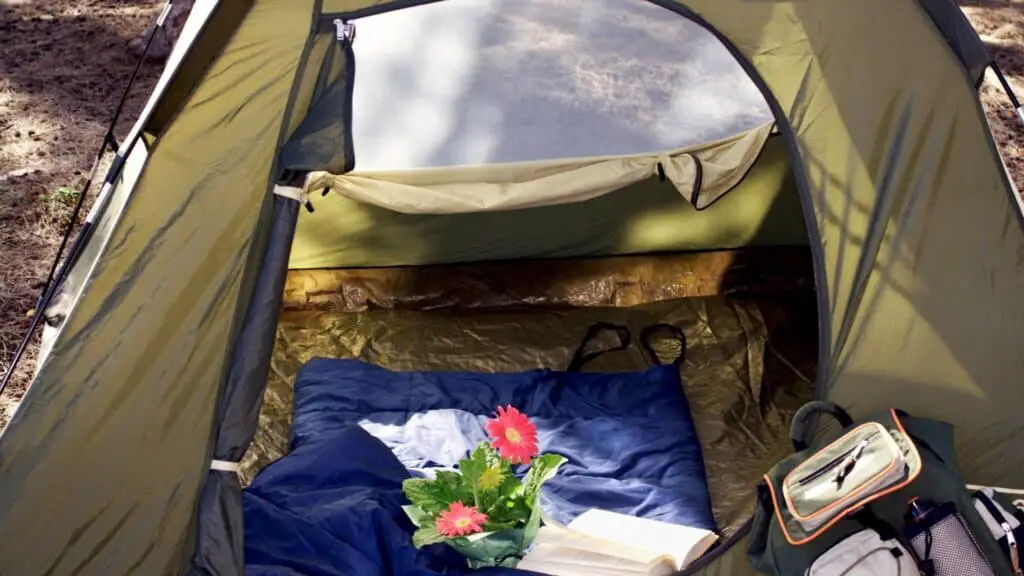
I have a love/hate relationship with single wall tents. Single wall tents are easier to setup, completely waterproof when setting up a tent in the pelting, and much cheaper, merely they have i glaring problem. Unmarried wall tents are horrible when it comes to ventilation!
That'due south not a problem when you're camping ground in mild threescore°-70°F weather, but it can cause serious condensation issues in hot weather. Your tent volition be completely waterproof while setting it up with the windows and doors airtight, just you're left with a poorly ventilated sealed off tent.
When yous're inside the tent, yous need to keep the doors and windows closed to keep out rain. You can try your darndest to eliminate outside moisture, just there's no way to completely go rid of condensation in a unmarried wall tent. I'll go over dealing with condensation in more than detail below.
10. Look Into Fast Pitch, Floorless, and Outside Pole Tents

The vast bulk of people should choose double wall tents, but in that location are other options that work well in the rain. You tin also use a fast pitch, floorless, or outside pole tent. In that location are a handful of issues with each design, but they make information technology easy to ready a tent in the rain.
- Fast Pitch and Quick Pitch Tents: Equally the proper name implies, yous tin put up a fast pitch tent in a few minutes. Most quick/fast pitch tents are regular double walls (like the MSR Hubba Hubba NX) that you can utilize without the inner body. Information technology'southward basically only a rainfly that drapes over tent poles. There'southward no floor, door (bad with insects), or inner mesh section to deal with so you don't have to worry about rain getting inside your tent. Lay down a tent footprint inside your tent and you're good to become.
- Floorless Tents: Floorless tents are similar to Fast Pitch and Quick pitch options, but they take longer to setup. There'south less support poles to cut downward weight, but that means you lot demand to run out extra guy lines. Yous tin can however keep out outside pelting, but information technology will take longer to set upwards the tent.
- Exterior Pole Tents: Exterior pole tents are double walls with inside of the tent attached to the rainfly. So the inside of your tent doesn't get exposed to pelting and information technology speeds up the set up process. Just popular in the exterior poles and elevator up the tent into position.
You may want to check out my post explaining how to keep floorless tents dry.
11. Keep Your Gear Dry and Leave Wet Gear In A Dry Spot Exterior
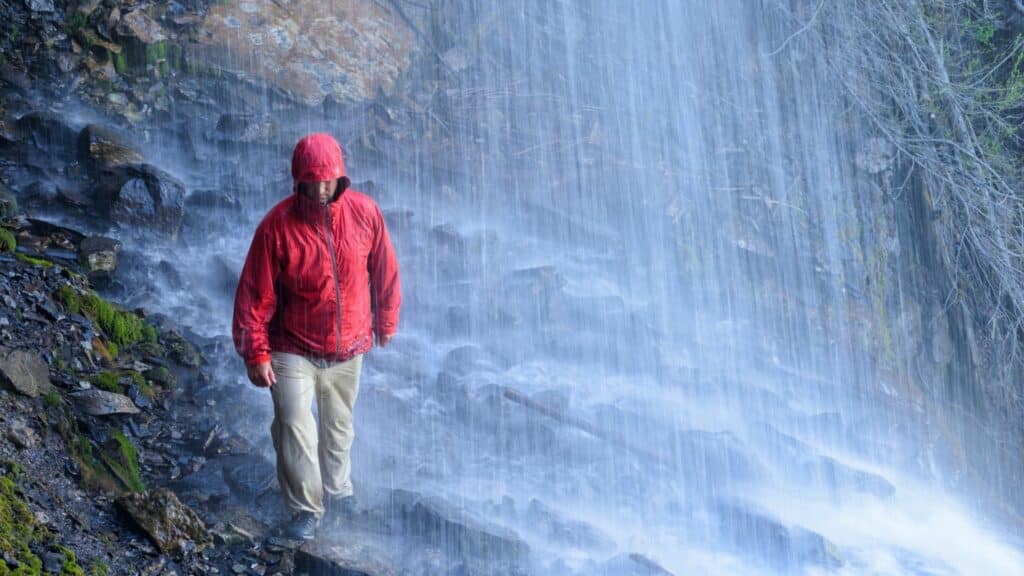
You tin can't bring wet gear inside your tent! So try to brand sure almost of your gear stays dry out so you don't accept to shop it exterior. Keep gear in dry out numberless and use both a pelting cover and pack liner inside your backpack. The rain encompass keeps the outside of your pack dry out, but h2o will leak through the shoulder straps and downwardly through the back pad.
I usually use an Osprey Ultralight Packliner, but there's a cheaper option. You tin utilise a 18 gallon trash compactor pocketbook (similar these) to line the inside of your pack. Trash compactor bags are puncture proof so they should last multiple weeks in your pack. You tin also spot fix punctures with a piece of duct tape.
Cheque out my post explaining how to dry moisture camping apparel and gear.
If you do finish up with moisture gear, you lot volition need to hang it up to dry outside your tent. This is 1 of the principal reasons why I recommend setting up a tarp over your tent. It gives yous a convenient spot to proceed your wet gear out of the rain to dry.
12. Use Rain Gear and H2o Resistant Shoes or Boots
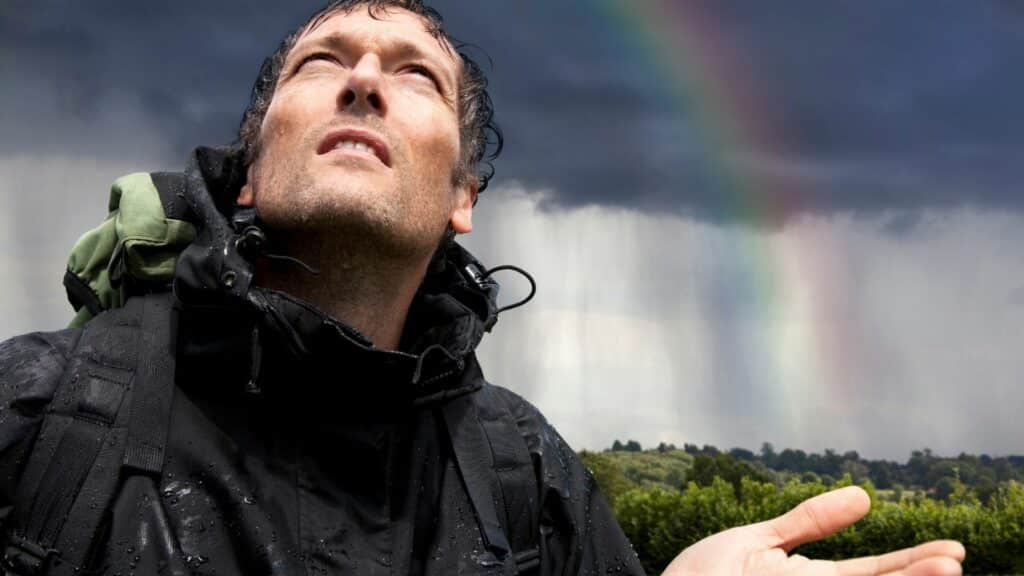
Make sure y'all buy a set of well-ventilated rain gear. Look for raingear with jacket pit zips or large mesh ventilation panels. You will stop up with excessive sweat and condensation forming on the inside of your jacket if at that place's poor ventilation. I actually similar my Columbia EvaPouration Jacket, but I'm sure there are cheaper options available.
The only fourth dimension you would need rain pants is when it'southward seriously pouring exterior. Your upper body blocks 90% of pelting and wet-wicking hiking pants will dry fast. I do keep a pair of cheap Frogg Toggs in my pack, but I just put them on when information technology'due south seriously storming.
You too demand to discover a way to keep your shoes and socks dry out. Personally, I hate 100% waterproof hiking boots/shoes, because they lead to excessive sweating. I recommend using a pair of water-resistant boots which are proficient enough in 99% of situations. Pair them with a pair of merino wool socks that feel fifty-fifty when they get damp and you're adept to become.
I also carry a pair of cheap safety sandals to wear effectually military camp when information technology's raining. They're comfortable for hanging out, they dry fast, and you can wipe off 90% of the water if they go wet.
13. Consider Condensation Issues Before Setting Upwards Camp
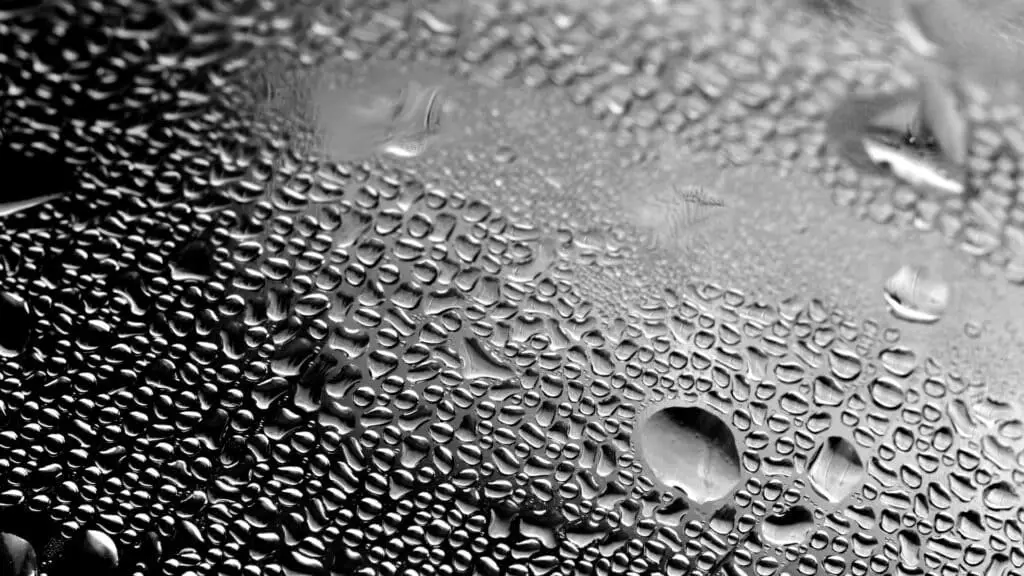
In that location are two main causes of condensation: poor ventilation and interior moisture. Go with a double wall tent with a mesh ceiling/walls to help with ventilation. Try to keep your door open when possible, pull your rainfly out some, and consider using a small fan in the tent if possible.
Eliminating interior moisture is easier said than done. Utilise towels and a sponge to dry off the floor, walls, and ceiling of your tent, and keep wet gear exterior. Hang your moisture gear under your tarp to dry or endeavor to position it under your lobby if you don't have a tarp.
Unfortunately, at that place's no way to completely eliminate interior wet. You breathe out water vapor with every jiff you lot accept, and sweat 2 liters of h2o per night. That'due south a lot of water going inside your tent so you definitely need to become ventilation bug nether control.
Check Out my camping in the rain ultimate guide for more tips. It goes over every other matter you need to know about camping in the rain.
Source: https://thehikingauthority.com/how-to-set-up-a-tent-in-the-rain-and-keep-it-dry/

0 Response to "How To Set Up Tent In Rain"
Post a Comment